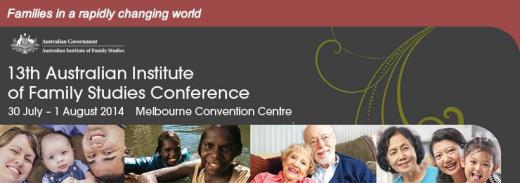AIFS CONFERENCE 2014

Barbara Beard attended this three day conference in Melbourne which showcased current and emerging research into children and families. This is a brief summary of the material presented at the conference but more information and references can be supplied by Westir by request. Day 1 of the conference commenced with the keynote speaker, followed by the Ministerial address and then the Welcome to Country by Aunty Di Kerr; an impressive Wurundjeri Elder. Kevin Andrews, Minister for Social Services gave the Ministerial opening address. He spoke about the vision of the government relating to child well being, a vision that focuses on intact families. Each day commenced with a Keynote Speaker who would also host a panel session at the end of the day.
2014 AUSTRALIAN INSTITUTE OF FAMILY STUDIES (AIFS) CONFERENCE – 30 JULY 2014 – 1 AUGUST 2014
Barbara Beard attended this three day conference in Melbourne which showcased current and emerging research into children and families. This is a brief summary of the material presented at the conference but more information and references can be supplied by Westir by request. Day 1 of the conference commenced with the keynote speaker, followed by the Ministerial address and then the Welcome to Country by Aunty Di Kerr; an impressive Wurundjeri Elder. Kevin Andrews, Minister for Social Services gave the Ministerial opening address. He spoke about the vision of the government relating to child well being, a vision that focuses on intact families. Each day commenced with a Keynote Speaker who would also host a panel session at the end of the day.
KEYNOTE SPEAKERS
Day 1: Trevor Huddleston from the UK government outlined the current economic challenges facing the UK Government and their policy responses including austerity measures and a change to the way welfare is delivered.
Day 2: Dorothy Scott from the University of South Australia spoke about child protection and the need for families to be able to access assistance for multiple services from a single service provider rather than multiple providers. She also spoke about the importance of stable foster care rather than multiple placements – there is a point when the number of placements becomes so detrimental that the child may as well as been left at home.
Day 3: Paul Amato is the Arnold and Bette Hoffman Professor of Family Sociology and Demography from, Pennsylvania State University. His research interests include the causes and consequences of divorce, marriage and marital quality, and psychological well-being over the life course. Paul spoke about the emotional and financial benefits of marriage for both partners. By the end of his talk it became clear that the benefits were actually related more to having a supportive partner rather than being married as the benefits also applied in cohabitation and same sex relationships. In fact, women became less happy and healthy in marriage but men become healthier and happier. He did not broach the wellbeing of people in bad marriages and if this improved once they left the marriage. There were a number of gaps and inconsistencies in his research and the questions from the floor highlighted some of these.
BREAKOUT SESSIONS
Day 1 morning session – “Preventing child abuse and neglect”
This session covered various aspects of prevention of child abuse and neglect. South Australia is currently undergoing a makeover of their reporting system with the aim of changing from a forensic model (what went wrong?) to a prevention (let’s stop it before it happens) model based on strengthening families. The speaker said the main thing is that workers need to believe that families can change. The second speaker spoke about how many home visits were needed to prevent child abuse and neglect. However, home visits by nurses generally focus on child health, immunisation and breast feeding rather than child neglect and abuse. There was a suggestion that women who were experiencing domestic violence tend to drop out of home visits so that the risk of the baby being removed is lowered. The final speaker outlined a review of programs in schools for the prevention of child sexual abuse. Although the programs were thought to be helpful, there is in fact very little evidence to support this as there has been a scarcity of robust evaluation.
Day 1 afternoon session – “Ageing”
In the past retirement was generally accepted as being the cessation of full-time work and the commencement full-time retirement but over the last few decades retirement has come to mean different things to different people. There is still a tendency for manual workers to retire full-time but many people mix casual, part-time or voluntary work with a version of retirement. Another researcher had explored the coordination of retirement between partners and found that the reasons for retirement vary between men and women. It seemed that ill health of the male partner was a major reason for both but other factors came into play, not least job satisfaction. Mental health of older persons with arthritis was also discussed in relation to social support. This study found that people coped better with illness when they had strong social support but as the illness became worse they perceived the support they received to be less.
Day 2 morning breakout session – “Family violence services”
Much of this session focused on the need for change and the ability for families to access multiple types of assistance without having to access multiple services. One constant problem with mandatory reporting of family violence is the way it deters women from seeking help as they risk of having their children removed or being highlighted in the system as ‘at risk’. There was also discussion about men’s change programs which aim to re-educate the perpetrators of violence without negating the victim’s story. Another speaker from Relationship Australia spoke about how they have placed workers in two different courts on days that vulnerable people may be attending. This aims to initiate contact with vulnerable people and develop relationships not only with court attendees but magistrates and legal workers by being visible at court. However, for this model to work the attendance needs to be consistent. This system of court attendance was described as a ‘warm’ referral system.
Day 2 Afternoon breakout session – “Financial support for new parents”
An alternative to the proposed paid parental scheme was outlined in this session. It was similar to the HEC S style scheme proposed by Chapman but different in that it was not just aimed at mothers as the loan could be recouped from fathers. The loan could be repaid by whichever parent was working. The next speaker had researched new mothers who had qualified for the now discontinued baby bonus. She discovered that contrary to media reports the baby bonus was not used by low income families to buy new televisions but to stretch their budget and buy essentials. It was found that the removal of the bonus would disadvantage low income mothers who did not qualify for paid parental leave. The final speaker had researched mothers returning to paid employment. The research did not show an influx of mothers returning to work once their children started school but rather a gradual increase. The proportion of working mothers in Australia is still below the OECD average. The speaker also spoke about the possibilities provided by the new Australian Census and Longitudinal Data set from the ABS for researching working mothers. The data set provides the ability to track mothers through the stages of motherhood and changes in the family as a whole. This data set was spoken about at length on Day 3.
Day 3 breakout session –
Symposium: Australian families: New Insights from longitudinal Census data
This was a symposium highlighting the possibilities provided by the new Australian Census
Longitudinal Data set; a data set developed by the ABS using matched pairs from the 2006 and 2011 Censuses. It is possible to track people and families across censuses. The confidence level of the matched pairs being the same person is more than 90% but due to names not being used there could be a few pairs which are not in fact the same person. However, the probability is so high the ABS is confident of the quality of the data and its ability to contribute to quality research. There were three presentations of projects which had used the data.
Lixia Qu & Caroline Daley – “Australians’ journeys through life – changes in family composition”. It is possible to track family composition over time and identify increases and decreases in families due to marriage, divorce, re-partnering, arrival and departure of children and other family members. This can be viewed against employment, working hours and housing changes. Sub population groups can also be considered including Indigenous families, family who need assistance and CALD families. This has the potential to contribute greatly to policy decisions and therefore impact service delivery.
Lixia Qu made another presentation about “Leaving and returning to the parental home”. The data was analysed to track young people and whether they lived at home or away from home. This captured those who had been at home or away in 2006 and then tracked where they lived in 2011 producing data of who had left home, who had left and returned. The limitation was in tracking those who left and returned between census dates. The data indicated that girls who live with single fathers or step fathers leave home first, and boys who live with both biological parents are the last to leave. Culture also plays a part with Australian and New Zealand children leaving first and Greek boys leaving last. Many people in the audience came to the conclusion they were stuck with their adult children for quite a while yet – particularly if their child was the biological male child of both parents.
The final presentation was about changes in Indigenous identification. The data allowed researchers to identify Indigenous people and whether they newly identified or had previously identified themselves as Indigenous. The researchers tracked changes for Indigenous persons and found higher levels of professionals, higher numbers of children born to one Indigenous and one non-Indigenous parent and those living in urban rather than rural areas. The presenter said his findings so far have implications for policy making. This was an interesting and engaging end to the conference.
PANEL SESSIONS
Day 1 – “Strengthening families and breaking cycles of disadvantage through policy and program innovation”
This discussion covered a range of views from a panel of Trevor Huddleston (UK Govt), Sue Regan (HC Coombs Policy Forum), Sean Innis (Dept of Social Services) and Paul Ronalds (Save the Children Australia). Trevor Huddleston and Sean Innis put forward conservative types of solutions to the problem whereas Sue Regan pointed out the economic situations in the UK and Australia are vastly different and solutions can’t just be transported country to country. Paul Ronalds outlined the factors that appear to prevent change including funding cycles, NGOs not being nimble enough to facilitate change and money being used in the wrong level of policy and implementation. He was passionate about the need to change the way governments and NGOs do things in order to achieve stronger families and healthier happier children.
Day 2 – “Complex needs and packaged problems” Dorothy Scott, Rev. Tim Costello, Prof. Ngiare Brown, and Prof Ross Homel as panel.
Dorothy started the session by saying previous generations lived in what we would now consider poverty but previous generations weren’t subject to the same stigmatisation (I would disagree with this and say that poverty was accepted as “being ones lot” and people were supposed to know their station in life and this in itself is a form of stigmatisation).
Ngiare Brown put forward that racism and discrimination add to the problems of Indigenous people regardless of their socioeconomic situation. Policies of segregation, protections etc. have not helped at all. She doubts if progress has been made since then. Now it is not about skin colour but race.
Tim Costello felt that ownership, leadership and imagination are necessary if complex needs are to be met. Patriarchal attitudes are back on the agenda. We are now much richer than our parents. He also said that both sides of politics are appalling with their leaders urging us to “feel the pain of McMansion people”, and telling us we are all victims. He says we have lost our perspective. How do we close the gap and whose responsibility is it?
Professor Ross Homel spoke of justice reinvestment with a data driven response to decrease crime and improve communities. Data could be used to pinpoint where prisoners came from and money could then be put into preventing crime. We need primary prevention with child youth partnerships, collective impact etc. Collective impact could overcome fragmentation. A shared measurement system is needed with an independent backbone organisation. There is a need to have an agreed shared goal for change and a vision – it sounds wonderful until you try to do it. He said creating the condition for collective impact and data sharing is really really hard.
OVERALL THOUGHTS ABOUT THE CONFERENCE
Many of the presenters highlighted the problems faced by families seeking help within a Domestic or Family Violence context. They often have to navigate multiple agencies and run a very real risk of having their children removed in the process. That is; the more contact they have to have to seek help = a higher the risk of a child being removed. Other themes were the problem of the funding being dictated by political and funding cycles more than actual need. Many also bemoaned the lack of long term vision in the implementation and funding duration of services and the inability to fix long term problems with short term funding and changing political stances.
The sessions outlining research using the new Australian Census longitudinal dataset were very interesting and generated a lot of talk. The conference also coincided with the airing of “Life at 9”, the latest in a series which has followed a group of children from birth. The series uses as its basis the Longitudinal Study of Australian Children, which is connected to AIFS and some of the presenters also used this data set in their research. Overall, a very informative 3 days which included information about new data sets, critique of existing policies and ideas for new policies as well as showcasing many talented and innovative researchers.


